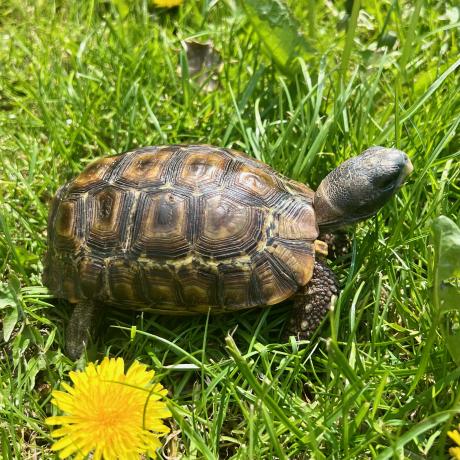

The Bells Hinged Back Tortoise is a small/medium sized semi-tropical tortoise with a huge character! They require higher humidity levels compared to other species, meaning that they can be kept in a well ventilated vivarium setup.
As the name would suggest, the Bells Hinged Back Tortoise has a hinge on the underside to protect the rear limbs and tail from predators. This is located on the 4th and 5th costals and the 7th and 8th peripherals in adults.
They are a small/medium sized tortoise reaching 22-25cm (8-10 inches). They have a smooth shell compared to the other Hinged Tortoises which have serrated edges. Specimens from open grassland and savannahs tend to have a deeper shell whereas ones found living within a rocky terrain are compressed to squeeze into those tight gaps. Hatchlings have a dark shell with prominent scutes (the ringed area on the shell); as they grow this lightens to a straw like colour with darker ringed scutes.
A healthy animal should have a solid, smooth domed shell with no pyramiding. They have a strong beak similar to birds, in order to eat the tough vegetation and meat protein in their diet; often using their claws to hold food in place while they eat. Males will generally have longer tails than females, and as they grow larger the plastron (underside of the shell) will begin to concave to facilitate breeding.
Bells Hinged Back Tortoises live in tropical to subtropical areas of Africa. They can be found living in open grassland, savannahs or rocky terrains but not desert or semi desert regions.
Unlike other more commonly kept species of tortoises, Bells Hinged Back Tortoises do best housed in normal reptile type vivariums. The humidity levels need to be 60-80% and it can be difficult to achieve this in an open top tortoise table. For this species a 4ftx2ft vivarium should be the minimum though a larger floor space is always appreciated by this species.
We recommend using a combination of a Basking Bulb controlled by a Thermostat and a T5 UVB kit to heat and light your tortoise table. It is important that you check the basking temperature you will be providing with this equipment. The recommended basking spot temperature is around 28-32°C and down to 20°C on the cool end of the enclosure. They will generally require 12-14 hours daylight and at night, lights should be turned off. Most tortoises can be kept at room temperature, simulating the natural temperature drop they experience in the wild as the sun goes down, this species in particular often drop down extremely cool overnight in the wild.
For substrate, use a soil/coir, sand and orchid bark mix; this is ideal with some leaf litter and moss added on top to retain humidity. We would recommend placing a tray with damp substrate to help with the humidity levels; this will also prevent any damage to your enclosure.
As previously mentioned, humidity is the key to keeping this species healthy and active. They become more active before and during rains in Africa; therefore regular misting of water should be made within the enclosure. The use of a humidity box/area would be beneficial as this will prevent any damage to your enclosure. They also benefit from having a luke-warm bath at least twice a week.
Décor is important for this species. Not only does it make the environment look nice aesthetically, but it provides environmental enrichment for the tortoise, essential for its physical and mental wellbeing. Remember that tortoises need items such as shallow bark or rocks to climb over and plenty of plants to graze on as they would in the wild.
Tortoises require a spacious, but shallow pool to drink from and bathe in. Be prepared, they will readily defecate in this as tortoises are able to absorb a small amount of liquid via their cloaca; which in turn can stimulate a bowel movement!
The Bells Hinged Back Tortoise is omnivore, meaning they require both 50% vegetable and fruits along with 50% insects and occasional meats (defrosted rodents work well) within their diet. Feeding is very easy as they will take a vast amount of different foods. To name a few vegetables and fruits; leafy greens, carrots, dandelion, cress, mushrooms, cucumber, tomatoes, melon, banana, orange, grapes, peach and other soft fruits. Insects taken in captivity are; crickets, mealworms, earthworms, snails Cockroaches, and several other suitably sized insects may be taken. They will also occasionally take small amounts of scrambled eggs and uncooked lean meat. We strongly urge you to forage for a good variety of the available reptile safe edible plants for your tortoise. By doing so, you will be providing your pet with the best nutritional balance that nature has to offer!
A tortoises natural wild diet consists of thousands of different plant species, each containing unique vitamins and minerals which contribute to the overall health of the tortoise. It is very important that you supplement the diet of your tortoise with calcium and vitamins to ensure they are getting the perfect balance. You can simply sprinkle the supplements over the top of the food you provide your tortoise- think of it as lightly seasoning the food! This is essential for all reptiles and helps to prevent a number of preventable conditions such as metabolic bone disease (soft, deformed bones and shells) Runny eyes, kidney and liver problems.